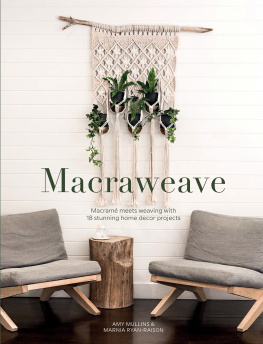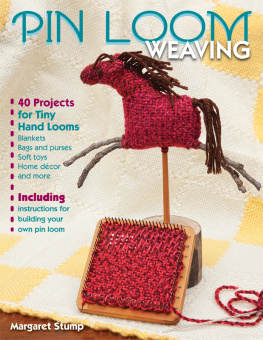small Loom
&freeform
Weaving
five ways to weave

Barbara Matthiessen


Copyright 2008 Creative Publishing international, Inc.
All rights reserved. No part of this work covered by the copyrights hereon may be reproduced or used in any form or by any meansgraphic, electronic, or mechanical, including photocopying, recording, taping of information on storage and retrieval systemswithout the written permission of the publisher.
Due to differing conditions, materials, and skill levels, the publisher and various manufacturers disclaim any liability for unsatisfactory results or injury due to improper use of tools, materials, or information in this publication.
First published in the United States of America by
Creative Publishing international, Inc., a member of
Quayside Publishing Group
400 First Avenue North
Suite 300
Minneapolis, MN 55401
1-800-328-3895
www.creativepub.com
Digital edition: 978-1-61673-282-0
Hardcover edition: 978-1-58923-361-4
ISBN-10: 1-58923-361-1
10 9 8 7 6 5 4 3 2 1
Library of Congress Cataloging-in-Publication Data
Matthiessen, Barbara.
Small loom and freeform weaving : five ways to weave / Barbara Matthiessen.
p. cm.
ISBN 1-58923-361-1
1. Hand weaving. 2. Handlooms. I. Title.
TT848.M3835 2008
746.14--dc22 2007049018
CIP
Copy Editor: Julia Maranan
Proofreader: Carol Polakowski
Book Design: Rachel Fitzgibbon
Cover Design: everlution design
Page Layout: Rachel Fitzgibbon
Illustrations: Michael Wanke
Photographs: Ned Witrodgen
Printed in China
CONTENTS
INTRODUCTION

Weaving just might be our most ancient art form and undoubtedly the most common and useful. Baskets, braids, and cloth have been woven from indigenous plant materials and animal hair for thousands of years in all cultures. In these cultures, weaving has supplied a multitude of items from containers and clothing to decorative elements of comfort and beauty.
Gorgeous yarns, fibers, and wool seduce meI love the way they feel and look. Weaving allows me to justify my compulsion by making fun, practical, and pleasing projects for my home, family, friends, and myself. Working with these materials is relaxing, rewarding, and easier than you might imagine.
For those of you already working with yarns and fibers, weaving will be easy to add to your skill set since many of the tools, terms, and techniques are also used in knitting, crocheting, and needlework. Novice yarn enthusiasts will be delighted to see that there are few necessary tools to purchase to get started on this adventure. Weaving truly has something to offer to everyone.
Small looms, such as those used in this book, are ideal to introduce the joys of weaving and are practical for many smaller-scale projects. They are portable and inexpensive, yet produce wonderful goods. You can also create your own looms with flat boards and hair combs, or use pins and foam-core board for a method called pin weaving. With a little imagination, youll discover that you can weave freeform directly onto many natural and hand-fashioned frameworks, like a bicycle rim, a wire artists easel, or a simple arrangement of nails pounded into a board. Each loom style or weaving method has its own advantages; however, many of the projects can be done on more than one loom with simple adaptations.
Most of the projects in this book can be done in an evening or during a weekend, which makes them perfect to jazz up an outfit or for last-minute gifts. You might even be able to use up yarn left over from other projects, making these FREE! From super-simple to artsy/funky, there is a project here for everyone who wants to try their hand at weaving.
GETTING STARTED

DESIGN BASICS
What is the first step when designing for weaving? Determining the function. You need to consider the end use of the project in the very beginning of the design process. By recognizing the limits, or lack of limits, for your particular project, you will make better choices throughout the design process.
Ask yourself some questions: Does this project need to be washable? How much durability do I need? What feel or drape do I need for this project? Will this be an art piece with no limits?
When choosing materials, be sure to read their labels for fiber content and laundering instructions. You really do not want to weave a cardigan that cannot be washed! On the other hand, wall hangings that are only occasionally vacuumed can utilize almost any material. For more on choosing materials, refer to Weaving Materials ().
Ideally, a design will marry texture, color, and form into a pleasing combination. Heres how each of these elements applies to weaving.
Texture
Texture is one of the most apparent characteristics of weaving, and the easiest to produce. Two choices, material and stitch or pattern, can determine whether the texture has a smooth, even finish or if its lumpy, bumpy, or fluffy. Smooth materials and a balanced weave produce the smoothest finish and make lovely linens and delightful-to-wear goods. Lumpy, bumpy, and fluffy textures are made using textured materials along with a variety of stitches, such as Rya and Soumak. These deep textures work well on tapestries and art pieces and as accents on wearable and home dcor pieces.
One way to learn about texture is to create a sampler using a variety of materials and stitches. Making a sampler will also give you an idea as to warp tension, interplay of warp with weft, and a feel for the process that will assist you when designing. After you have read this Basics section, warp up a flat loom and experiment using materials that you have on hand, mixing in some of the stitches from this book. Play, and you will learn a great deal about the process.
Color
Color tends to be the feature that first draws us in, but it can also be the most confusing when designing for weaving. There are many theories about the use of color, but here is an overview of the basics:
Hue is pure color and the name of the family on the color spectrum. Red, pink, and burgundy are in the same color family.
Value is the amount of lightness or darkness in a color family. Pink is a light value of red.
Intensity is the brightness or dullness of a color. A color is most intense when it is closest to the pure color, as in bright red.
No discussion about color can leave out the color wheel and its importance in the language of design. Briefly, here are some color wheel terms you may find helpful:
Primary colors are pure colors from which all other colors are created. They are red, yellow, and blue.
Secondary colors are a mix of two primary colors (for example, orange is a blend of red and yellow). Secondary colors are orange, purple, and green.








